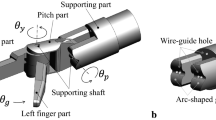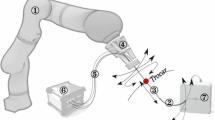Abstract
Purpose
Robots with a spherical unactuated wrist can be used for minimally invasive surgery. With such a robot, positioning the wrist center controls the instrument tip position when assuming that the insertion site behaves like a lever with a fixed and known fulcrum. In practice, this assumption is not always respected. In this paper we first study the practical consequences of this problem in terms of tip precision positioning. We then propose a robotic control scheme that improves the precision compared to the fixed point assumption approach.
Methods
In the first part of the paper, data recorded during robot-assisted transrectal needle positioning for prostate biopsies (nine patients) are exploited to quantify the positioning error induced by the use of a fixed point hypothesis in the positioning process. In the second part of the paper advanced control techniques allow for the online identification of a locally linear system that describes a model characterized by anisotropy and center displacement. A laboratory apparatus is used to demonstrate the resulting improvement on tip positioning precision.
Results
Errors obtained by processing the clinical data reach 7.5 mm at the tip in average. Errors obtained with the laboratory apparatus drop from 2.4 mm in average to 0.8 mm when using real-time model update.













Similar content being viewed by others
References
Guthart G, Salisbury J (2000) The intuitive telesurgery system: overview and application. In: Proceedings of the IEEE international conference on robotics and automation, pp 618–621. http://ci.nii.ac.jp/naid/20001085379/en/
Pham CD, Coutinho F, Leite AC, Lizarralde F, From PJ, Johansson R (2015) In: 2015 IEEE/RSJ international conference on intelligent robots and systems (IROS), pp. 1440–1446. https://doi.org/10.1109/IROS.2015.7353557
Konietschke R, Hagn U, Nickl M, Jörg S, Tobergte A, Passig G, Seibold U, Le-Tien L, Kübler B, Gröger M, Fröhlich F, Rink C, Albu-Schäffer A, Grebenstein M, Ortmaier T, Hirzinger G (2009) In: IEEE international conference on robotics and automation, pp 1589–1590. http://elib.dlr.de/76870/
Boctor EM, Webster RJ, Mathieu H, Fichtinger G (2004) Virtual remote center of motion control for needle placement robots. Comput Aided Surg 9(5):175. https://doi.org/10.3109/10929080500097661
Low SC, Phee L (2004) In: IEEE conference on robotics, automation and mechatronics, vol 1, pp 37–42. https://doi.org/10.1109/RAMECH.2004.1438888
Ortmaier T, Hirzinger G (2000) In: Proceedings of the 2000 IEEE/RSJ international conference on intelligent robots and systems (IROS 2000) (Cat. No.00CH37113), vol 1, pp 565–571. https://doi.org/10.1109/IROS.2000.894664
Villers A, Mouton D, Rébillard X, Chautard D, Ruffion A, Staerman F et al (2004) Conditions de réalisation et schéma de ponctionslors d’une première série de biopsies prostatiques. Progr Urol 14:144
Ouzzane A, Coloby P, Mignard JP, Allegre JP, Soulié M, Rébillard X, Salomon L, Villers A (2011) Recommendations for best practice for prostate biopsy. Prog Urol 21(1):18. https://doi.org/10.1016/j.purol.2010.07.001
Marchal M (2006) Ph.D. thesis from Joseph Fourier University
Poquet C, Mozer P, Morel G, Vitrani MA (2013) In: 2013 IEEE/RSJ international conference on intelligent robots and systems (IROS), pp 4084–4091. https://doi.org/10.1109/IROS.2013.6696941. http://ieeexplore.ieee.org/document/6696941/
Krieger A, Iordachita II, Guion P, Singh AK, Kaushal A, Menard C, Pinto PA, Camphausen K, Fichtinger G, Whitcomb LL (2011) An MRI-compatible robotic system with hybrid tracking for MRI-guided prostate intervention. IEEE Trans Biomed Eng 58(11):3049. https://doi.org/10.1109/TBME.2011.2134096
Stoianovici D, Kim C, Petrisor D, Jun C, Lim S, Ball MW, Ross A, Macura KJ, Allaf ME (2017) MR safe robot, FDA clearance, safety and feasibility prostate biopsy clinical trial. IEEE ASME Trans Mechatron 22(1):115. https://doi.org/10.1109/TMECH.2016.2618362
Hungr N, Baumann M, Long JA, Troccaz J (2012) A 3-D ultrasound robotic prostate brachytherapy system With prostate motion tracking. IEEE Trans Robot 28(6):1382. https://doi.org/10.1109/TRO.2012.2203051
Bassan H, Hayes T, Patel R, Moallem M (2007, April) In: 2007 IEEE international conference on robotics and automation, pp 617–622
Schneider CM, Okamura AM, Fichtinger G (2004) A robotic system for transrectal needle insertion into the prostate with integrated ultrasound. Proc IEEE Int Conf Robot Autom 1:365–370. https://doi.org/10.1109/ROBOT.2004.1307177
Wei Z, Ding M, Downey D, Fenster A (2005) Medical image computing and computer-assisted intervention. In: Duncan J, Gerig G (eds) MICCAI 2005, Lecture Notes in Computer Science, vol 3750. Springer, Berlin, pp 17–24
Poquet C, Mozer P, Vitrani MA, Morel G (2015) Mechatronic design of a new robot for force control in minimally invasive surgery. IEEE ASME Trans Mechatron 20(1):186. https://doi.org/10.1109/TMECH.2014.2314859
Vitrani MA, Baumann M, Reversat D, Morel G, Moreau-Gaudry A, Mozer P (2016) Prostate biopsies assisted by comanipulated probe-holder: first in man. Int J Comput Assist Radiol Surg. 11(6):1153. https://doi.org/10.1007/s11548-016-1399-y
Dong L, Morel G (2016) In: 2016 IEEE international conference on robotics and automation (ICRA), pp 4109–4114. https://doi.org/10.1109/ICRA.2016.7487602
Funding
This work has been partially supported by the French state funds managed by the BPI within the FUI’17-MIRAS project and through the funds managed by the ANR within the Investissements d’Avenir program (Labex CAMI) under reference ANR-11-LABX-0004.
Author information
Authors and Affiliations
Corresponding author
Ethics declarations
Conflict of interest
The authors declare that they have no conflict of interest.
Ethical approval
The research protocol for a clinical trial was authorized by the sponsor of the clinical study (Grenoble University Hospital) and the relevant legal authorities through the reference PROSBOT-Apollo Biopsies assisted by co-manipulated robot-Pilot Clinical trial; 2015; Acceptance number NCT02132975.
Human and animal rights
This article does not contain any studies with animals performed by any of the authors.
Informed consent
Informed consent was obtained from all individual participants included in the study.
Rights and permissions
About this article
Cite this article
Chalard, R., Reversat, D., Morel, G. et al. Precisely positioning the tip of an instrument inserted through an orifice with a free wrist robot: application to prostate biopsies. Int J CARS 13, 611–618 (2018). https://doi.org/10.1007/s11548-018-1718-6
Received:
Accepted:
Published:
Issue Date:
DOI: https://doi.org/10.1007/s11548-018-1718-6




